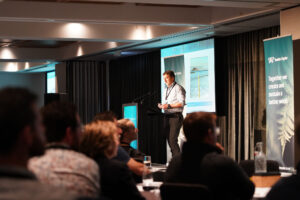New Zealand Geotechnical Society (NZGS) Symposium 2021
System response using dynamic effective stress modelling can capture the holistic behaviour of a potentially liquefiable soil deposit, including interaction between different soil layers. Compared to a conventional liquefaction triggering analysis, a system response assessment can either predict more or less damage depending on the characteristics of the soil profile. This paper describes a case study where considering the system response resulted in a more realistic prediction of liquefaction effects than a simplified CPT based triggering assessment. Show more…The soil profile at the site comprises upper loose to medium dense sand (from 0-9 m depth), overlying silt (9- 12.5 m), and overlying a lower loose sand layer (12.5-19.5 m). A simplified liquefaction triggering analysis predicted liquefaction occurring from 2 to 6 m depth and 12.5 m to 19.5 m in an Ultimate Limit State (ULS) earthquake event.
Several large diameter tanks are to be constructed at the site. Using a simplified liquefaction analysis, ground improvement was required to 8 m depth to improve bearing capacity and mitigate differential settlements.
A liquefaction system response analysis was carried out using an effective stress time history analysis of a 1D soil column. The model was created in FLAC with a PM4Sand constitutive model for the liquefiable sand layers. The results showed that liquefaction would first occur in the very loose sand layer from 12 to 19.5 m depth, reducing accelerations in the soil column above by approximately 50%. Because of this “base isolation” effect, liquefaction was not triggered in the loose to medium dense sand above 9 m depth in the ULS event. From this result it was concluded that ground improvement is not required to support the tank
. Show less…




















